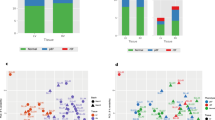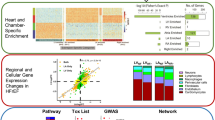Abstract
Limited data are available in humans regarding the molecular biology of hibernating myocardium (HM). The aim of this study was to identify gene expression patterns distinctive for human HM. We compared in patients with ischemic left ventricular dysfunction the gene expression profile of myocardial biopsies from HM (n = 5), as identified by positron emission tomography, with expression profiles of matched biopsies from normally perfused myocardium by using cDNA array analysis. Gene-specific polymerase chain reaction of selected genes and immunohistochemical staining of desmoplakin were used to validate our technical approach. Of 4171 transcripts examined, we identified 86 to be differentially expressed. Compared to normally perfused myocardium, 21 genes showed an increased expression and 65 genes a decreased expression in HM. Functional clustering revealed changes in the expression of genes associated with transcription, protein modification and phosphorylation, regulation of apoptosis, and intercellular communication. Besides the reported upregulation of β-adrenergic receptor kinase-1 in heart failure, we observed new gene expression patterns, such as the upregulation of fas-activated serine/threonine kinase (FAST) or reduced expression of desmoplakin. Downregulation of desmoplakin in cardiomyocytes from HM was also seen on the protein level. Gene expression analysis provided novel insights into the pathophysiological changes of HM. Impaired intercellular communication as suggested by decreased expression of desmoplakin may be an important feature of contractile dysfunction in HM.
Similar content being viewed by others
References
Ross J Jr (1991) Myocardial perfusion-contraction matching. Implications for coronary heart disease and hibernation. Circulation 83:1076–1083
Frangogiannis NG, Shimoni S, Chang SM, Ren G, Dewald O, Gersch C, Shan K, Aggeli C, Reardon M, Letsou GV, Espada R, Ramchandani M, Entman ML, Zoghbi WA (2002) Active interstitial remodeling: an important process in the hibernating human myocardium. J Am Coll Cardiol 39:1468–1474
Haas F, Augustin N, Holper K, Wottke M, Haehnel C, Nekolla S, Meisner H, Lange R, Schwaiger M (2000) Time course and extent of improvement of dysfunctioning myocardium in patients with coronary artery disease and severely depressed left ventricular function after revascularization: correlation with positron emission tomographic findings. J Am Coll Cardiol 36:1927–1934
Marshall RC, Tillisch JH, Phelps ME, Huang SC, Carson R, Henze E, Schelbert HR (1983) Identification and differentiation of resting myocardial ischemia and infarction in man with positron computed tomography, 18F-labeled fluorodeoxyglucose and N-13 ammonia. Circulation 67:766–778
Brunken R, Tillisch J, Schwaiger M, Child JS, Marshall R, Mandelkern M, Phelps ME, Schelbert HR (1986) Regional perfusion, glucose metabolism, and wall motion in patients with chronic electrocardiographic Q wave infarctions: evidence for persistence of viable tissue in some infarct regions by positron emission tomography. Circulation 73:951–963
Canty JM Jr, Suzuki G, Banas MD, Verheyen F, Borgers M, Fallavollita JA (2004) Hibernating myocardium: chronically adapted to ischemia but vulnerable to sudden death. Circ Res 94: 1142–1149
Frangogiannis NG, Shimoni S, Chang SM, Ren G, Shan K, Aggeli C, Reardon MJ, Letsou GV, Espada R, Ramchandani M, Entman ML, Zoghbi WA (2002) Evidence for an active inflammatory process in the hibernating human myocardium. Am J Pathol 160:1425–1433
Depre C, Kim SJ, John AS, Huang Y, Rimoldi OE, Pepper JR, Dreyfus GD, Gaussin V, Pennell DJ, Vatner DE, Camici PG, Vatner SF (2004) Program of cell survival underlying human and experimental hibernating myocardium. Circ Res 95:433–440
Haas F, Jennen L, Heinzmann U, Augustin N, Wottke M, Schwaiger M, Lange R (2001) Ischemically compromised myocardium displays different time-courses of functional recovery: correlation with morphological alterations? Eur J Cardiothorac Surg 20:290–298
Zohlnhofer D, Richter T, Neumann F, Nuhrenberg T, Wessely R, Brandl R, Murr A, Klein CA, Baeuerle PA (2001) Transcriptome analysis reveals a role of interferon-gamma in human neointima formation. Mol Cell 7:1059–1069
Zohlnhofer D, Klein CA, Richter T, Brandl R, Murr A, Nuhrenberg T, Schomig A, Baeuerle PA, Neumann FJ (2001) Gene expression profiling of human stent-induced neointima by cDNA array analysis of microscopic specimens retrieved by helix cutter atherectomy: Detection of FK506-binding protein 12 upregulation. Circulation 103:1396–1402
Tusher VG, Tibshirani R, Chu G (2001) Significance analysis of microarrays applied to the ionizing radiation response. Proc Natl Acad Sci USA 98:5116–5121
Maere S, Heymans K, Kuiper M (2005) BinGO: a Cytoscape plugin to assess overrepresentation of gene ontology categories in biological networks. Bioinformatics 21:3448–3449
Al Shahrour F, Minguez P, Vaquerizas JM, Conde L, Dopazo J (2005) BABELOMICS: a suite of web tools for functional annotation and analysis of groups of genes in high-throughput experiments. Nucleic Acids Res 33:W460–W464
Mishra S, Sabbah HN, Rastogi S, Imai M, Gupta RC (2005) Reduced sarcoplasmic reticulum Ca2+ uptake and increased Na+-Ca2+ exchanger expression in left ventricle myocardium of dogs with progression of heart failure. Heart Vessels 20:23–32
Getsios S, Huen AC, Green KJ (2004) Working out the strength and flexibility of desmosomes. Nat Rev Mol Cell Biol 5:271–281
Bristow MR, Ginsburg R, Minobe W, Cubicciotti RS, Sageman WS, Lurie K, Billingham ME, Harrison DC, Stinson EB (1982) Decreased catecholamine sensitivity and beta-adrenergic-receptor density in failing human hearts. N Engl J Med 307:205–211
Lefkowitz RJ, Rockman HA, Koch WJ (2000) Catecholamines, cardiac beta-adrenergic receptors, and heart failure. Circulation 101:1634–1637
Melon PG, de Landsheere CM, Degueldre C, Peters JL, Kulbertus HE, Pierard LA (1997) Relation between contractile reserve and positron emission tomographic patterns of perfusion and glucose utilization in chronic ischemic left ventricular dysfunction: implications for identification of myocardial viability. J Am Coll Cardiol 30:1651–1659
Iyer VS, Canty, JM Jr (2005) Regional desensitization of betaadrenergic receptor signaling in swine with chronic hibernating myocardium. Circ Res 97:789–795
Fallavollita JA, Malm BJ, Canty, JM Jr (2003) Hibernating myocardium retains metabolic and contractile reserve despite regional reductions in flow, function, and oxygen consumption at rest. Circ Res 92:48–55
Elsasser A, Muller KD, Skwara W, Bode C, Kubler W, Vogt AM (2002) Severe energy deprivation of human hibernating myocardium as possible common pathomechanism of contractile dysfunction, structural degeneration and cell death. J Am Coll Cardiol 39:1189–1198
Elsasser A, Vogt AM, Nef H, Kostin S, Mollmann H, Skwara W, Bode C, Hamm C, Schaper J (2004) Human hibernating myocardium is jeopardized by apoptotic and autophagic cell death. J Am Coll Cardiol 43:2191–2199
Nishikimi T, Hagaman JR, Takahashi N, Kim HS, Matsuoka H, Smithies O, Maeda N (2005) Increased susceptibility to heart failure in response to volume overload in mice lacking natriuretic peptide receptor-A gene. Cardiovasc Res 66:94–103
Pellieux C, Foletti A, Peduto G, Aubert JF, Nussberger J, Beermann F, Brunner HR, Pedrazzini T (2001) Dilated cardiomyopathy and impaired cardiac hypertrophic response to angiotensin II in mice lacking FGF-2. J Clin Invest 108:1843–1851
Elsasser A, Schlepper M, Zimmermann R, Muller KD, Strasser R, Klovekorn WP, Schaper J (1998) The extracellular matrix in hibernating myocardium — a significant factor causing structural defects and cardiac dysfunction. Mol Cell Biochem 186:147–158
Deten A, Holzl A, Leicht M, Barth W, Zimmer HG (2001) Changes in extracellular matrix and in transforming growth factor beta isoforms after coronary artery ligation in rats. J Mol Cell Cardiol 33:1191–1207
Hao J, Ju H, Zhao S, Junaid A, Scammell-La Fleur T, Dixon IM (1999) Elevation of expression of Smads 2, 3, and 4, decorin and TGF-beta in the chronic phase of myocardial infarct scar healing. J Mol Cell Cardiol 31:667–678
Gallicano GI, Bauer C, Fuchs E (2001) Rescuing desmoplakin function in extra-embryonic ectoderm reveals the importance of this protein in embryonic heart, neuroepithelium, skin and vasculature. Development 128:929–941
Alcalai R, Metzger S, Rosenheck S, Meiner V, Chajek-Shaul T (2003) A recessive mutation in desmoplakin causes arrhythmogenic right ventricular dysplasia, skin disorder, and woolly hair. J Am Coll Cardiol 42:319–327
Rampazzo A, Nava A, Malacrida S, Beffagna G, Bauce B, Rossi V, Zimbello R, Simionati B, Basso C, Thiene G, Towbin JA, Danieli GA (2002) Mutation in human desmoplakin domain binding to plakoglobin causes a dominant form of arrhythmogenic right ventricular cardiomyopathy. Am J Hum Genet 71:1200–1206
Norgett EE, Hatsell SJ, Carvajal-Huerta L, Cabezas JC, Common J, Purkis PE, Whittock N, Leigh IM, Stevens HP, Kelsell DP (2000) Recessive mutation in desmoplakin disrupts desmoplakin-intermediate filament interactions and causes dilated cardiomyopathy, woolly hair and keratoderma. Hum Mol Genet 9:2761–2766
Raasch W, Bartels T, Gieselberg A, Dendorfer A, Dominiak P (2002) Angiotensin I-converting enzyme inhibition increases cardiac catecholamine content and reduces monoamine oxidase activity via an angiotensin type 1 receptor-mediated mechanism. J Pharmacol Exp Ther 300:428–434
Thijssen VL, Borgers M, Lenders MH, Ramaekers FC, Suzuki G, Palka B, Fallavollita JA, Thomas SA, Canty, JM Jr (2004) Temporal and spatial variations in structural protein expression during the progression from stunned to hibernating myocardium. Circulation 110:3313–3321
Author information
Authors and Affiliations
Corresponding author
Rights and permissions
About this article
Cite this article
Zohlnhöfer, D., Nührenberg, T.G., Haas, F. et al. Myocardial gene expression of matched hibernating and control tissue from patients with ischemic left ventricular dysfunction. Heart Vessels 23, 230–242 (2008). https://doi.org/10.1007/s00380-007-1035-4
Received:
Accepted:
Published:
Issue Date:
DOI: https://doi.org/10.1007/s00380-007-1035-4




